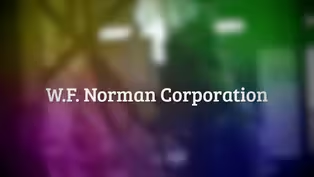
W.F. Norman Corporation History
Clip: Season 3 Episode 1 | 5m 11sVideo has Closed Captions
W.F. Norman Corporation – Nevada, MO
We learn about the history of this family-owned stamped tin ceiling manufacturing company that has been in operation since 1898 (125 years).
Problems playing video? | Closed Captioning Feedback
Problems playing video? | Closed Captioning Feedback
Making is a local public television program presented by KMOS

W.F. Norman Corporation History
Clip: Season 3 Episode 1 | 5m 11sVideo has Closed Captions
We learn about the history of this family-owned stamped tin ceiling manufacturing company that has been in operation since 1898 (125 years).
Problems playing video? | Closed Captioning Feedback
How to Watch Making
Making is available to stream on pbs.org and the free PBS App, available on iPhone, Apple TV, Android TV, Android smartphones, Amazon Fire TV, Amazon Fire Tablet, Roku, Samsung Smart TV, and Vizio.
Providing Support for PBS.org
Learn Moreabout PBS online sponsorship(upbeat music) - W.F.
Norman started this business in 1898.
They actually started across the street, he and a partner.
There were as many as two dozen tin ceiling companies in the east.
There wasn't one this far out west.
And he had been involved for five years selling tin ceilings for another business, and decided to start his own sheet metal manufacturing business.
We make tin ceilings, which are the original W.F.
Norman product.
140 designs in a 1909 catalog that we still send out, or show online, that are the original designs.
And besides the catalog items where people can look on the website or look in our catalogs and buy things that have catalog numbers, an awful lot of our business has evolved into replicating pieces that are sent to us.
So businesses in New York City, or Philadelphia, or Chicago who have a building cornice that's in disrepair, and some of it's good and some of it isn't, can send to us pieces from their building and have replicated and returned to them additional ones.
Because we have the ability to take a print of what they send us, and make stamping dyes, and send them back new copper or zinc metal to put their building back the way it was maybe in 1885 or 1890.
The earliest parts of the building are the northwest corner that started as a church in 1896.
W.F.
Norman and his partner started across the street, but moved into this building and began to expand it in about 1901 or '02.
They built this office.
They added onto the factory.
Until they had a fire in 1909 that burned the whole building down.
They built it back, added on about another 1/3 in 1925, to its current size.
It's between 50,000 and 60,000 square feet, so it's in the neighborhood of 1/2 a square block.
The office is about the way it was in 1909 or 1910 when they rebuilt it.
And we haven't hardly remodeled it or added on.
It's the furniture, and the roll tops, and the fireplaces, and the beveled glass, and the original tin ceilings.
And so we like to keep it as much as possible the way it is.
We use things here that you see in museums.
Old brakes, which are bending machines, and shears, which are the cutting machines that you see in old machinery museums.
The drop hammers are 120 or 130 years old.
And the power system, you know, the belts and the pulleys, and the power system work the same way as they did early 1900s.
And we can't think of a new machine that would make it better.
We think it's the best way.
The control we have and the way to have the die set, we think it's the best way to make the ceilings.
(gentle music) My parents came to Nevada in 1978, which was the 80th year of the business, and bought it from Franklin Norman, who was W.F.
Norman's grandson.
My dad had worked in the farm implement business for 25 years or so.
He started in his 20s working for a company called Allis Chalmers in Milwaukee.
And then worked for other companies in various states that sold implements for farmers.
So he had, not just a manufacturing background, but a sales and marketing background.
It was probably very helpful in promoting and finding customers for tin ceilings.
The tin ceilings hadn't been made since the 1930s when tin ceilings sort of dried up everywhere because of the Depression, and then scarcity metal during World War II.
They made other things outta sheet metal here, some of which they'd made for decades, and some were new.
We have a whole list of things that were made.
The one we still make is temporary grave markers, which is a metal marker that cemeteries use to mark a grave while the stone is being made.
Those have been made here, it's a product that's been made here since 1918.
But they made shower stalls through the years.
They made and got brochures for home incinerators made outta sheet metal.
Nursery flats, those pans where you put starter plants in, they made those even into our time.
So they made other products.
Staying in business, never were closing down after tin ceilings went out of style.
But the equipment and the stamping dyes were here, and my parents determined that there'd be a market for it in a year or two.
Maybe by 1980 we were making tin ceilings again.
(tin rattling)
Video has Closed Captions
Clip: S3 Ep1 | 6m 21s | Belger Crane Yard Studios – Ceramics studio and Gallery in Kansas City, MO (6m 21s)
Belger Crane Yard Studios How-To
Video has Closed Captions
Clip: S3 Ep1 | 6m 1s | How-To segment @ Belger Crane Yard Studios (6m 1s)
W.F. Norman Corporation Process
Video has Closed Captions
Clip: S3 Ep1 | 5m 50s | W.F. Norman Corporation – Nevada, MO (5m 50s)
Providing Support for PBS.org
Learn Moreabout PBS online sponsorshipSupport for PBS provided by:
Making is a local public television program presented by KMOS
















